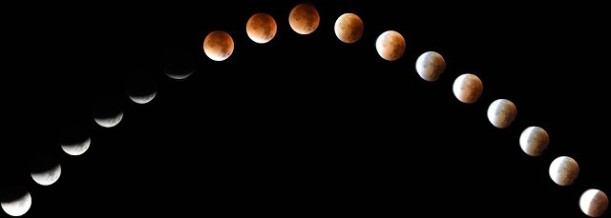On Monday 21 January 2019, all of us in the UK will be able to watch a total eclipse of the Moon. This will be the best Total Lunar Eclipse viewable from the UK until 2028! Those looking out on Monday will see that the Moon is a deep red colour whilst it is in “totality”. It is this red colour has led to the name ‘Blood Moon’. The middle of the eclipse, called Greatest Totality (GT) is at 05:12 GMT in Hatfield, Hertfordshire (times for key points of the eclipse are highlighted in bold further down). So an early start if you want to see the entire event! As of writing it is forecast to be clear in Hatfield and the surrounding area.

A composite image showing the different stages of a Total Lunar Eclipse as seen from Earth.
A total eclipse of the Moon occurs because the orbits of the Sun, Earth and Moon align such that the Moon moves directly into the shadow of the Earth. An alignment like this is also known as a syzygy, a (usually) straight line arrangement of three or more Solar System objects. However, unlike a Total Solar Eclipse where the Moon blocks out the disc of the Sun, we can still see the surface of the Moon during a Total Lunar Eclipse. This seems like it wouldn’t be possible, as the Earth is blocking the light from the Sun, but during totality light from the Sun is scattered through the Earth’s atmosphere and still reaches the surface of the Moon, an effect known as Rayleigh Scattering. Rayleigh Scattering is what causes the sky to be blue and sunsets to appear red.
Therefore, the scattered light reaching the Moon is from the sunsets and sunrises all around the world.

A cartoon showing the physical explanation of the different parts of the Earth’s shadow.
The Moon will be high in the early morning sky when the astronomical phenomena begins, at an altitude of around 45°, WSW. The Moon enters the partial shadow of the Earth, the “penumbra” (pen, from the Latin for ‘almost, nearly’ and umbra for ‘shadow’) at 02:36.
Partial eclipse begins at 03:34, here you will see the curved edge of the Earth’s shadow begin to fall on the Moon.
Totality is when the Moon is in the full shadow of the Earth, the “umbra”, beginning at 04:41, lasting 62 minutes until 05:43, this is the portion of the eclipse the Moon will appear red.
So if you’re not a morning person, perhaps you can wake just a little early, before 05:43, to catch some of all the Earthly sunrises and sunsets dancing off the Moon’s surface.
Partial eclipse ends at 06:51 and it is all over at 07:48.
Somewhere between three to five Total Lunar Eclipses occur approximately every 5 years, but from any one location on Earth, the chances of viewing one is approximately every few years. For example, the next few Total Lunar Eclipses visible from the UK, which include greatest totality, are: 16th May 2022 (GT 5:11, occurs as the Moon sets), 31st December 2028 (GT 16:51), 18th Oct 2032 (GT 20:02) and 14th April 2033 (GT 20:12, occurs as the Moon rises). The previous Total Lunar Eclipse visible from the UK was on 27th July 2018 (GT 21:21). As you can see from these dates, they don’t occur very often and the time that they occur can be relatively ‘unfriendly’ if you don’t want to get up early or stay up late to watch it.
A Total Lunar Eclipse creates great photography opportunities as well as experiencing something amazing that doesn’t occur on any other planet in our Solar System (or maybe in the entire Universe!). Unlike a Solar Eclipse where you need special filtered glasses to avoid eye damage, Lunar Eclipses are safe to view with the naked eye.
Tips for watching the Blood Moon on Monday:
- You can watch from your house if you don’t want to go out into the cold winter morning. Otherwise, a garden, balcony or local park will suffice; pack a folding chair or blanket, wrap up warm and, a thermos of hot drink and some snacks (who doesn’t want to snack while watching an astronomical phenomenon), a camera and friends and family.
- Go to bed early on Sunday night 😊
- One more thing: fingers crossed for clear skies.
Times and dates source: https://www.timeanddate.com/eclipse/
